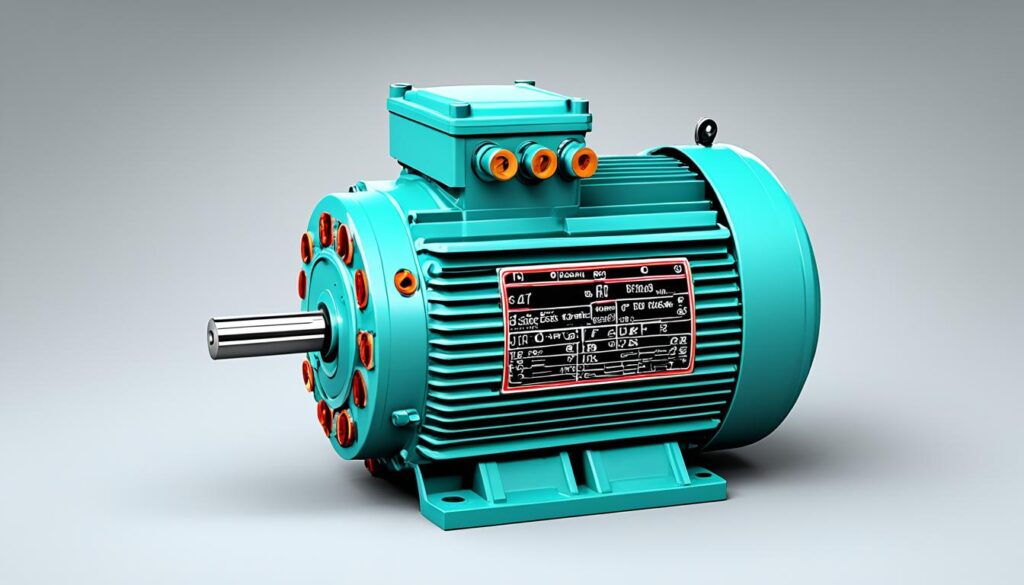Welcome to our guide on 3 phase motor ampere calculations! Electricians and engineers often encounter the need to accurately determine the current draw of motors in 3 phase circuits, and understanding the calculations involved is crucial. In this article, we will simplify the process for you, providing an overview of the formulas and steps required to calculate motor amperage.
Whether you are calculating motor amperage for industrial applications or residential use, our guide will equip you with the knowledge and skills to perform accurate ampere calculations every time. By following these steps, you will be able to optimize the performance and efficiency of 3 phase motors, ensuring their safe and reliable operation.
Calculating motor amperage involves various factors, including voltage, power factor, and motor efficiency. It is essential to consider these elements to obtain precise results. Throughout this article, we will delve into the importance of power factor and motor efficiency in ampere calculations, as well as discuss the impact of voltage system variations and motor power ratings on the results.
Stay tuned as we guide you through the step-by-step process of calculating motor amperage in 3 phase circuits. You’ll gain valuable insights that will help you accurately determine motor current and optimize electrical systems for efficient operation.
Key Takeaways:
- Understanding the formulas and steps involved in calculating motor amperage for 3 phase motors is crucial for electricians and engineers.
- Consider factors such as voltage, power factor, and motor efficiency to obtain accurate results in ampere calculations.
- Account for voltage system variations and motor power ratings to ensure precise ampere calculations.
- Accurate motor ampere calculations optimize motor performance and efficiency.
- Following a practical guide for calculating motor amperage will simplify the process and yield accurate results.
Understanding 3 Phase Motor Ampere Calculations
In this section, we will provide a comprehensive understanding of 3 phase motor ampere calculations. Understanding how to accurately calculate the current draw of motors in 3 phase circuits is crucial for electricians and engineers in ensuring optimal performance and efficiency.
Basics of Motor Current Calculation Formula
The motor current calculation formula is an essential tool for determining the amperage of 3 phase motors. This formula takes into account the voltage and power factor to calculate the current draw accurately. By understanding the components of the formula and how they interact, electrical professionals can calculate motor amperage with precision.
Importance of Power Factor in Calculating Motor Amperage
Power factor plays a vital role in motor ampere calculation. It measures the efficiency of power usage by the motor and affects the overall current draw. A high power factor indicates efficient power utilization, resulting in lower amperage requirements. Considering the power factor while calculating motor amperage is crucial for accurate and efficient electrical designs.
How Motor Efficiency Influences Current Draw
Motor efficiency has a direct impact on current draw. Highly efficient motors typically require lower amperage compared to less efficient ones for the same power output. By considering motor efficiency during ampere calculation, electricians and engineers can optimize energy consumption, reduce costs, and improve overall system performance.
Practical Guide for Calculating 3 Phase Motor Amperage
In this section, we will provide a practical guide for calculating amperage in 3 phase motors. By following these step-by-step instructions and guidelines, electricians and engineers can accurately determine the current draw of motors in 3 phase circuits, optimizing their performance and efficiency.
To calculate the amperage of a 3 phase motor, follow the below steps:
- Step 1: Measure the line-to-line voltage (V) of the 3 phase circuit using a voltmeter. Record the value.
- Step 2: Determine the power factor (PF) of the motor. The power factor can be obtained from the motor’s data sheet or calculated using power factor correction techniques.
- Step 3: Calculate the apparent power (S) of the motor using the formula S = V * Iph, where Iph is the line current. This formula considers the power factor of the motor.
- Step 4: Calculate the real power (P) of the motor using the formula P = S * PF. This formula takes into account the power factor of the motor.
- Step 5: Determine the motor efficiency (η) from the motor’s data sheet or by calculating it using η = P / S. This value represents the efficiency of the motor.
- Step 6: Calculate the motor current (I) using the formula I = P / (V * √3). This formula considers the line-to-line voltage and efficiency of the motor.
By following these steps, you will be able to accurately calculate the amperage of a 3 phase motor. Remember to consider the power factor and efficiency of the motor for increased accuracy and optimized motor performance.

| Step | Description | Formula | Result |
|---|---|---|---|
| Step 1 | Measure the line-to-line voltage | V = 415 V | 415 V |
| Step 2 | Determine the power factor | PF = 0.9 | 0.9 |
| Step 3 | Calculate apparent power | S = V * Iph | 1000 kVA |
| Step 4 | Calculate real power | P = S * PF | 900 kW |
| Step 5 | Determine motor efficiency | η = P / S | 0.9 |
| Step 6 | Calculate motor current | I = P / (V * √3) | 1107 A |
Referencing the above sample calculation table, you can see a step-by-step breakdown of the amperage calculation process for a 3 phase motor. Utilize this information to ensure accurate and efficient motor ampere calculation in your projects.
Factors Affecting Motor Ampere Rating Calculation
In order to accurately calculate the motor ampere rating, it is important to consider several factors that can impact the results. This section will discuss two key factors: the impact of voltage system variations on ampere calculation and the importance of accounting for motor power ratings in current estimation.
Impact of Voltage System Variations on Ampere Calculation
The voltage supplied to a motor can vary depending on the electrical system in which it operates. This variation in voltage can directly affect the ampere calculation. Lower voltage levels will require higher amperage to deliver the same power, while higher voltage levels will result in lower amperage. Therefore, it is crucial to consider the specific voltage system in place when calculating motor ampere ratings. By accounting for voltage system variations, electricians and engineers can ensure accurate and efficient current estimations.
Accounting for Motor Power Ratings in Current Estimation
Another important factor to consider in motor ampere rating calculation is the power rating of the motor. The power rating indicates the maximum amount of power the motor can handle without overheating. When estimating current draw, it is essential to take into account the power rating of the motor. Failure to do so may result in under or overestimating the current, leading to potential performance issues or equipment damage. By accounting for the motor’s power rating, electricians and engineers can make more precise current calculations, optimizing the overall operation of the motor.
| Factors | Impact on Ampere Calculation |
|---|---|
| Voltage System Variations | Determines the amperage required based on the specific voltage level supplied to the motor. |
| Motor Power Ratings | Influences current estimation by indicating the maximum power the motor can handle without overheating. |
Conclusion
In conclusion, 3 phase motor current calculation requires an understanding of the motor current calculation formula, the importance of power factor, and the influence of motor efficiency. By following the step-by-step guide provided in this article, electricians and engineers can accurately determine the current draw of motors in 3 phase circuits.
Key takeaways for motor ampere calculation include considering voltage system variations, accounting for motor power ratings, and ensuring accurate ampere calculations. By taking these factors into account, professionals can optimize the performance and efficiency of 3 phase motors.
By summarizing the formulas, steps, and factors involved in determining motor amperage, this article provides a comprehensive overview for electricians and engineers. It serves as a valuable resource for quick recaps and a reference guide to apply in their calculations.
FAQ
What is the formula for calculating motor amperage in a 3 phase motor?
Motor ampere formula in a 3 phase motor is: Current (A) = (kW × 1000) / (1.732 × Voltage × Power Factor)
Why is power factor important in calculating motor amperage?
Power factor is important in calculating motor amperage because it represents the efficiency of the motor. A lower power factor means the motor draws more current from the power supply, increasing the amperage.
How does motor efficiency affect current draw?
Motor efficiency directly impacts current draw. A more efficient motor requires less current to operate compared to a less efficient motor with the same power output. Taking motor efficiency into account ensures accurate ampere calculations.
What is a practical guide for calculating 3 phase motor amperage?
Follow these steps to calculate 3 phase motor amperage: 1. Determine the motor power (kW). 2. Find the line-to-line voltage (V). 3. Calculate the power factor (PF). 4. Use the formula: Current (A) = (kW × 1000) / (1.732 × V × PF).
How do voltage system variations impact ampere calculation?
Voltage system variations can impact ampere calculation. It is important to account for different voltage levels in the formula to ensure accurate motor amperage calculations.
How should I consider motor power ratings when estimating current?
To estimate current accurately, consider the power ratings of the motor in the formula for motor ampere calculation. The power rating represents the electrical power output of the motor and helps determine the current draw.

